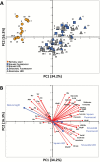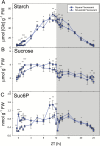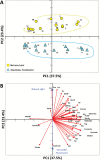Getting back to nature: a reality check for experiments in controlled environments
- PMID: 28673035
- PMCID: PMC5853417
- DOI: 10.1093/jxb/erx220
Getting back to nature: a reality check for experiments in controlled environments
Abstract
Irradiance from sunlight changes in a sinusoidal manner during the day, with irregular fluctuations due to clouds, and light-dark shifts at dawn and dusk are gradual. Experiments in controlled environments typically expose plants to constant irradiance during the day and abrupt light-dark transitions. To compare the effects on metabolism of sunlight versus artificial light regimes, Arabidopsis thaliana plants were grown in a naturally illuminated greenhouse around the vernal equinox, and in controlled environment chambers with a 12-h photoperiod and either constant or sinusoidal light profiles, using either white fluorescent tubes or light-emitting diodes (LEDs) tuned to a sunlight-like spectrum as the light source. Rosettes were sampled throughout a 24-h diurnal cycle for metabolite analysis. The diurnal metabolite profiles revealed that carbon and nitrogen metabolism differed significantly between sunlight and artificial light conditions. The variability of sunlight within and between days could be a factor underlying these differences. Pairwise comparisons of the artificial light sources (fluorescent versus LED) or the light profiles (constant versus sinusoidal) showed much smaller differences. The data indicate that energy-efficient LED lighting is an acceptable alternative to fluorescent lights, but results obtained from plants grown with either type of artificial lighting might not be representative of natural conditions.
Keywords: Amino acid; Arabidopsis; LED lighting; controlled environment; organic acid; starch; sucrose; thaliana; trehalose 6-phosphate; visible light spectrum.
© The Author 2017. Published by Oxford University Press on behalf of the Society for Experimental Biology.
Figures







References
-
- Britz SJ, Hungerford WE, Lee DR. 1987. Rhythms during extended dark periods determine rates of net photosynthesis and accumulation of starch and soluble sugars in subsequent light periods in leaves of Sorghum. Planta 171, 339–345. - PubMed
-
- Carillo P, Parisi D, Woodrow P, Pontecorvo G, Massaro G, Annunziata MG, Fuggi A, Sulpice R. 2011. Salt-induced accumulation of glycine betaine is inhibited by high light in durum wheat. Functional Plant Biology 38, 139–150. - PubMed
Publication types
MeSH terms
Substances
LinkOut - more resources
Full Text Sources
Other Literature Sources

